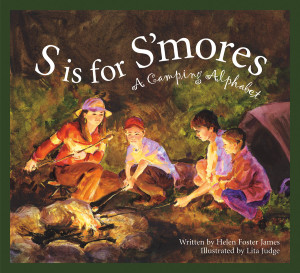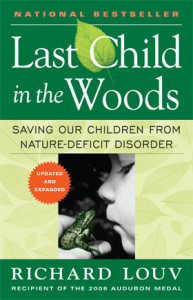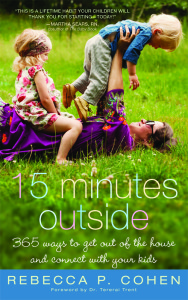What are You Reading?
- Blog What are You Reading?
Here at Hike it Baby we are all about encouraging families to get outdoors and enjoy nature! It's also fun to read about nature and our Hike it Baby members have reviewed books that are themed about nature or getting outside with families. From board books for infants to non-fiction for adults, here are some of the books members submitted reviews for.
Carlie Kallmann, Vancouver, WA
 S is for Smores: A Camping Alphabet by Helen Foster James and Lita Judge
A cute book that's great for kids big and small to help them preview what is to come or to talk about a previous experience!
Carlie Kallmann, Vancouver, WA
I Love Dirt!: 52 Activities to Help You and Your Kids Discover the Wonders of Nature by Jennifer Ward, Susie Ghahremani Richard Louv
Geared for kiddos roughly 3-8. This is a great book about different discoveries right below our very feet!
Carlie Kallmann, Vancouver, WA
Why Dirt Is Good: 5 Ways to Make Germs Your Friends by Mary Ruebush
This book is written by a Virologist and gives scientific reasons as to why dirt germs are good for you. While scientific in nature it was a readable and she gave many accounts of personal experiences.
Carlie Kallmann, Vancouver, WA
S is for Smores: A Camping Alphabet by Helen Foster James and Lita Judge
A cute book that's great for kids big and small to help them preview what is to come or to talk about a previous experience!
Carlie Kallmann, Vancouver, WA
I Love Dirt!: 52 Activities to Help You and Your Kids Discover the Wonders of Nature by Jennifer Ward, Susie Ghahremani Richard Louv
Geared for kiddos roughly 3-8. This is a great book about different discoveries right below our very feet!
Carlie Kallmann, Vancouver, WA
Why Dirt Is Good: 5 Ways to Make Germs Your Friends by Mary Ruebush
This book is written by a Virologist and gives scientific reasons as to why dirt germs are good for you. While scientific in nature it was a readable and she gave many accounts of personal experiences.
Carlie Kallmann, Vancouver, WA
 Last Child in the Woods: Saving Our Children From Nature-Deficit Disorder by Richard Louv
This man is a genius and so right on the money! This talks about how our kids are spending too much time inside which is causing what he calls Nature Deficit Disorder. This is a chapter book that will pull you in and have you saying "YES!" to everything he describes. You'll appreciate your HiB family that much more!
Carlie Kallmann, Vancouver, WA
The Nature Principle: Reconnecting with Life in a Virtual Age by Richard Louv
This is the sequel, if you will, to his other book " Last Child in the Woods:...". He talks about how ADULTS need nature too in our age of technology everywhere. He describes the many benefits of Vitamin "N" to our bodies and rhythms. It will make you put down the technology and jump into the dirt with your kids!
Alana Dimmick, Eatonville
Last Child in the Woods: Saving Our Children From Nature-Deficit Disorder by Richard Louv
This man is a genius and so right on the money! This talks about how our kids are spending too much time inside which is causing what he calls Nature Deficit Disorder. This is a chapter book that will pull you in and have you saying "YES!" to everything he describes. You'll appreciate your HiB family that much more!
Carlie Kallmann, Vancouver, WA
The Nature Principle: Reconnecting with Life in a Virtual Age by Richard Louv
This is the sequel, if you will, to his other book " Last Child in the Woods:...". He talks about how ADULTS need nature too in our age of technology everywhere. He describes the many benefits of Vitamin "N" to our bodies and rhythms. It will make you put down the technology and jump into the dirt with your kids!
Alana Dimmick, Eatonville
 15 Minutes Outside by Rebecca Cohen
Author Rebecca Cohen challenged herself and her family to get outside for 15 minutes every day for one year. She succeeded, and 365 Days Outside was born. In this book you will find one idea for an outdoor activity every single day for an entire year. The book is set up by month, beginning with an introduction and followed by a list of of things you can do outside with just 15 minutes for each day of the month. Some activities are geared toward older kids (elementary and beyond), but there are plenty of ideas for little ones, too. This makes a great reference book to pull out when looking for a little inspiration!
May, Austin
A Mountain Alphabet by Margaret Ruurs
This beautiful book has 26 pages of beautiful mountain scenes, one for each letter of the alphabet. Each letter's page incorporates as many plants, animals, natural features, and human adventurers that start with that letter of the alphabet as possible. The text doesn't mention all of them, so it's fun to search each page for as many letter-appropriate pictures as you can find! This is a family favorite with both toddler and parents in our house. The same author/illustrator duo also has another book, When We Go Camping, that's another favorite of ours.
Want to see more reviews? Check them out on our Hike it Baby Blog!
http://hikeitbaby.com/what-are-you-reading-2/
http://hikeitbaby.com/what-are-you-reading/
15 Minutes Outside by Rebecca Cohen
Author Rebecca Cohen challenged herself and her family to get outside for 15 minutes every day for one year. She succeeded, and 365 Days Outside was born. In this book you will find one idea for an outdoor activity every single day for an entire year. The book is set up by month, beginning with an introduction and followed by a list of of things you can do outside with just 15 minutes for each day of the month. Some activities are geared toward older kids (elementary and beyond), but there are plenty of ideas for little ones, too. This makes a great reference book to pull out when looking for a little inspiration!
May, Austin
A Mountain Alphabet by Margaret Ruurs
This beautiful book has 26 pages of beautiful mountain scenes, one for each letter of the alphabet. Each letter's page incorporates as many plants, animals, natural features, and human adventurers that start with that letter of the alphabet as possible. The text doesn't mention all of them, so it's fun to search each page for as many letter-appropriate pictures as you can find! This is a family favorite with both toddler and parents in our house. The same author/illustrator duo also has another book, When We Go Camping, that's another favorite of ours.
Want to see more reviews? Check them out on our Hike it Baby Blog!
http://hikeitbaby.com/what-are-you-reading-2/
http://hikeitbaby.com/what-are-you-reading/
What are YOU reading that inspires a love for nature? Share with us here and we will feature your review in an upcoming blog post!
 S is for Smores: A Camping Alphabet by Helen Foster James and Lita Judge
A cute book that's great for kids big and small to help them preview what is to come or to talk about a previous experience!
Carlie Kallmann, Vancouver, WA
I Love Dirt!: 52 Activities to Help You and Your Kids Discover the Wonders of Nature by Jennifer Ward, Susie Ghahremani Richard Louv
Geared for kiddos roughly 3-8. This is a great book about different discoveries right below our very feet!
Carlie Kallmann, Vancouver, WA
Why Dirt Is Good: 5 Ways to Make Germs Your Friends by Mary Ruebush
This book is written by a Virologist and gives scientific reasons as to why dirt germs are good for you. While scientific in nature it was a readable and she gave many accounts of personal experiences.
Carlie Kallmann, Vancouver, WA
S is for Smores: A Camping Alphabet by Helen Foster James and Lita Judge
A cute book that's great for kids big and small to help them preview what is to come or to talk about a previous experience!
Carlie Kallmann, Vancouver, WA
I Love Dirt!: 52 Activities to Help You and Your Kids Discover the Wonders of Nature by Jennifer Ward, Susie Ghahremani Richard Louv
Geared for kiddos roughly 3-8. This is a great book about different discoveries right below our very feet!
Carlie Kallmann, Vancouver, WA
Why Dirt Is Good: 5 Ways to Make Germs Your Friends by Mary Ruebush
This book is written by a Virologist and gives scientific reasons as to why dirt germs are good for you. While scientific in nature it was a readable and she gave many accounts of personal experiences.
Carlie Kallmann, Vancouver, WA
 Last Child in the Woods: Saving Our Children From Nature-Deficit Disorder by Richard Louv
This man is a genius and so right on the money! This talks about how our kids are spending too much time inside which is causing what he calls Nature Deficit Disorder. This is a chapter book that will pull you in and have you saying "YES!" to everything he describes. You'll appreciate your HiB family that much more!
Carlie Kallmann, Vancouver, WA
The Nature Principle: Reconnecting with Life in a Virtual Age by Richard Louv
This is the sequel, if you will, to his other book " Last Child in the Woods:...". He talks about how ADULTS need nature too in our age of technology everywhere. He describes the many benefits of Vitamin "N" to our bodies and rhythms. It will make you put down the technology and jump into the dirt with your kids!
Alana Dimmick, Eatonville
Last Child in the Woods: Saving Our Children From Nature-Deficit Disorder by Richard Louv
This man is a genius and so right on the money! This talks about how our kids are spending too much time inside which is causing what he calls Nature Deficit Disorder. This is a chapter book that will pull you in and have you saying "YES!" to everything he describes. You'll appreciate your HiB family that much more!
Carlie Kallmann, Vancouver, WA
The Nature Principle: Reconnecting with Life in a Virtual Age by Richard Louv
This is the sequel, if you will, to his other book " Last Child in the Woods:...". He talks about how ADULTS need nature too in our age of technology everywhere. He describes the many benefits of Vitamin "N" to our bodies and rhythms. It will make you put down the technology and jump into the dirt with your kids!
Alana Dimmick, Eatonville
 15 Minutes Outside by Rebecca Cohen
Author Rebecca Cohen challenged herself and her family to get outside for 15 minutes every day for one year. She succeeded, and 365 Days Outside was born. In this book you will find one idea for an outdoor activity every single day for an entire year. The book is set up by month, beginning with an introduction and followed by a list of of things you can do outside with just 15 minutes for each day of the month. Some activities are geared toward older kids (elementary and beyond), but there are plenty of ideas for little ones, too. This makes a great reference book to pull out when looking for a little inspiration!
May, Austin
A Mountain Alphabet by Margaret Ruurs
This beautiful book has 26 pages of beautiful mountain scenes, one for each letter of the alphabet. Each letter's page incorporates as many plants, animals, natural features, and human adventurers that start with that letter of the alphabet as possible. The text doesn't mention all of them, so it's fun to search each page for as many letter-appropriate pictures as you can find! This is a family favorite with both toddler and parents in our house. The same author/illustrator duo also has another book, When We Go Camping, that's another favorite of ours.
Want to see more reviews? Check them out on our Hike it Baby Blog!
http://hikeitbaby.com/what-are-you-reading-2/
http://hikeitbaby.com/what-are-you-reading/
15 Minutes Outside by Rebecca Cohen
Author Rebecca Cohen challenged herself and her family to get outside for 15 minutes every day for one year. She succeeded, and 365 Days Outside was born. In this book you will find one idea for an outdoor activity every single day for an entire year. The book is set up by month, beginning with an introduction and followed by a list of of things you can do outside with just 15 minutes for each day of the month. Some activities are geared toward older kids (elementary and beyond), but there are plenty of ideas for little ones, too. This makes a great reference book to pull out when looking for a little inspiration!
May, Austin
A Mountain Alphabet by Margaret Ruurs
This beautiful book has 26 pages of beautiful mountain scenes, one for each letter of the alphabet. Each letter's page incorporates as many plants, animals, natural features, and human adventurers that start with that letter of the alphabet as possible. The text doesn't mention all of them, so it's fun to search each page for as many letter-appropriate pictures as you can find! This is a family favorite with both toddler and parents in our house. The same author/illustrator duo also has another book, When We Go Camping, that's another favorite of ours.
Want to see more reviews? Check them out on our Hike it Baby Blog!
http://hikeitbaby.com/what-are-you-reading-2/
http://hikeitbaby.com/what-are-you-reading/
What are YOU reading that inspires a love for nature? Share with us here and we will feature your review in an upcoming blog post!
Related Content




Comments